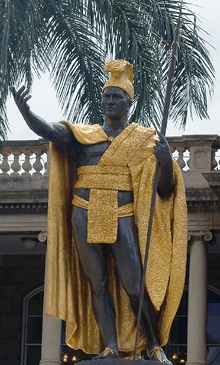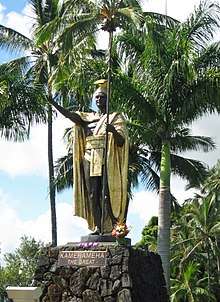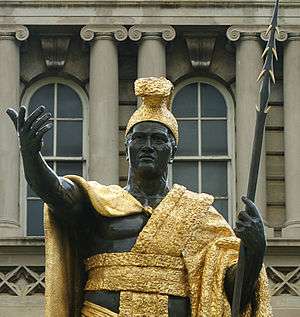Kamehameha statues
Several Kamehameha statues honor the monarch who founded the Kingdom of Hawaii.[1]

Original work
The pictured statue stands prominently in front of Aliʻiolani Hale in Honolulu, Hawaii. The statue had its origins in 1878 when Walter M. Gibson, a member of the Hawaiian government at the time, wanted to commemorate the 100-year arrival of Captain Cook to the Hawaiian Islands. The legislature appropriated $10,000 for the project and made Gibson the director of the project, which originally included native Hawaiians but they soon were off the project and Gibson ran the project by himself. Gibson contacted Thomas R. Gould, a Boston sculptor living abroad in Florence, Italy to create the statue.
Features
Even though photographs of Polynesians had been sent to him so that Gould could make an appropriate likeness, he seemed to ignore them. A Roman nose and more European features were adopted. This is most likely due to the fact that Gould was in Italy studying Roman sculpture. The stance of a Roman general with gesturing hand, spear, and cape are also Roman appropriations. The belt or sash on the statue's waist is a symbolic rendering of the Sacred Sash of Liloa. In 1880, the initial sculpture was sent to Paris, France, to be cast in bronze.[2]
However, historians have noted that from the photographs that were sent to Gould, certain features of the statues were influenced by Hawaiian brothers John Tamatoa Baker and Robert Hoapili Baker. Two photographs of the former survive, one in its original form and another in the form composite with the bare legs of a Hawaiian fisherman.[3]
During this time, David Kalākaua became king and was completing ʻIolani Palace which was his tribute to King Kamehameha I and to be the destination of the statue. The statue was too late for the 100th anniversary, but in 1883, the statue was placed aboard a ship and headed for Hawaii. Near the Falkland Islands the ship wrecked and the statue was thought lost. However, the Hawaiians had insured the statue for $12,000 and a second casting was quickly made.[4]
Replicas
Before the second statue could be sent, the original was recovered by some Falkland Islanders. They sold it to the Captain of the wrecked ship for $500, and the Captain then sold it to Gibson for $875. Now Hawaii has two statues. The original stands near the legendary king's birthplace in Kapaʻau in Kohala, on the island of Hawaiʻi. The re-ordered one stands in front of Aliʻiolani Hale.[5]
A third replica was commissioned when Hawaii attained statehood and was unveiled in 1969. It stood in the United States Capitol alongside the Father Damien Statue and was the heaviest statue in Statuary Hall, weighing 15,000 pounds. In 2008, shortly after Hawaii-born Barack Obama was nominated as the Democratic Party's candidate for the presidency, the statue was moved from a dark, back row of Statuary Hall to a prominent position in Emancipation Hall in the Capitol's new visitor center.
The Gould statue can be briefly seen in the opening credits of the original 1960s TV police drama Hawaii Five-O as well as the 2010 series reboot. The statue is also seen multiple times in a three-part series of Sanford and Son when the duo go on a vacation to Hawaii. The statue is seen on a pedestal outside the Hawaii Police Department Headquarters.[6]
Big Island

Another Kamahameha statue resides on the island of Hawaiʻi (known locally as the Big Island). It stands near downtown Hilo at the north end of the Wailoa River State Recreation Area, where it enjoys a king's view of Hilo Bay. The 14-foot (4.3 m) statue was sculpted by R. Sandrin at the Fracaro Foundry in Vicenza, Italy in 1963 but was not erected on this site and dedicated until June 1997. The statue was originally commissioned for $125,000 by the Princeville Corporation for their resort in Kauai. However, the people of Kauai did not want the statue erected there, as Kauai was never conquered by King Kamehameha I. Hilo, however, was one of the political centers of King Kamehameha I. Consequently, the Princeville Corporation donated the statue to the Big Island of Hawaii via the Kamehameha Schools Alumni Association, East Hawaii Chapter.[7]
Kane work
The Grand Wailea Resort Hotel & Spa on Maui is the home of a fifth Kamehameha statue. Hawaiian artist, author and historian Herb Kawainui Kane created the nine-and-a-half-foot work, which presides over the entrance of the hotel, facing the porte cochere. It is purported to be the most lifelike representation of the great warrior king.[8]
Las Vegas Statue
There was a sixth statue in Las Vegas, NV, along the Strip at the Hawaiian Marketplace. It was removed in January 2014 to make way for a Chili's.[9] It was then moved to Springs Preserve where it became weathered by the harsh desert elements, deemed beyond repair, and disposed.[10]
Kamehameha Day
Every year on or near the June 11 Kamehameha Day holiday, Kamehameha statues are ceremoniously draped in fresh lei fashioned in Hawaiʻi. The event is celebrated in the United States Capitol with traditional hula performances.[11]
Gallery
 Kapaʻau statue with schoolchildren of plantation workers in 1900s
Kapaʻau statue with schoolchildren of plantation workers in 1900s
- The replica in Emancipation Hall in the US Capitol Visitor Center[12]
 Closeup of Honolulu statue
Closeup of Honolulu statue
See also
- Kamehameha Statue (original cast)
- Kamehameha Statue (Honolulu cast)
Notes
- "Archived copy". Archived from the original on 2010-12-24. Retrieved 2013-07-09.CS1 maint: archived copy as title (link)
- "Let's Take a Walk Around Historic Honolulu". TripSavvy. Retrieved 2018-05-15.
- Adler, Jacob (1969). "Kamehameha Statue". The Hawaiian Journal of History. Honolulu: Hawaiian Historical Society. 3: 203–212. hdl:10524/570. OCLC 60626541.; Rose, Roger G. (1988). "Woodcarver F. N. Otremba and the Kamehameha Statue". The Hawaiian Journal of History. Honolulu: Hawaiian Historical Society. 22: 131–146. hdl:10524/505. OCLC 60626541.; Charlot, Jean (July 1969). "Letter To Jacob Adler On The Statue Of Kamehameha By Thomas R. Gould" (PDF). Jean Charlot Foundation. Cite journal requires
|journal=(help); Dekneef, Matthew (June 10, 2016). "Two Hawaiian Brothers Who Modeled For The Iconic Kamehameha Statue". Hawaiʻi Magazine. Honolulu. Retrieved November 15, 2016. - "Kamehameha I". Architect of the Capitol | United States Capitol. Retrieved 2018-05-15.
- "Archived copy". Archived from the original on 2010-12-20. Retrieved 2011-04-05.CS1 maint: archived copy as title (link)
- "King Kamehameha Statue, Oahu". www.to-hawaii.com. Retrieved 2018-05-15.
- "5 King Kamehameha Statues". Tamerlane's Thoughts. 2009-10-17. Retrieved 2018-05-15.
- "VisitTheUSA.com Homepage". Visit The USA. Retrieved 2018-05-15.
- Martin, Bradley (January 21, 2014). "King Kamehameha Departs the Hawaiian Marketplace". Eater Vegas. Retrieved 2018-05-15.
- Deniz, Lacy (September 25, 2018). "'It was never pono': Story of missing Kamehameha statue underscores need for greater cultural awareness". Hawaii News Now. Retrieved 2019-04-29.
- "King Kamehameha Day Events in Hawaii". www.hawaiiforvisitors.com. Retrieved 2018-05-15.
- "Kamehameha I". Architect of the Capitol | United States Capitol. Retrieved 2018-06-06.
References
- Adler, Jacob (1969). "The Kamehameha Statue". Hawaiian Journal of History. Honolulu: Hawaiian Historical Society. 3: 87–91. hdl:10125/6299.
- Loewen, James (2007). Lies Across America: What Our Historic Sites Get Wrong. Touchstone. pp. 40–43.
- Wharton, Glenn (2011). The Painted King: Art, Activism, and Authenticity in Hawaii. Honolulu: University of Hawaii Press.
External links
| Wikimedia Commons has media related to Statues of Kamehameha I. |
